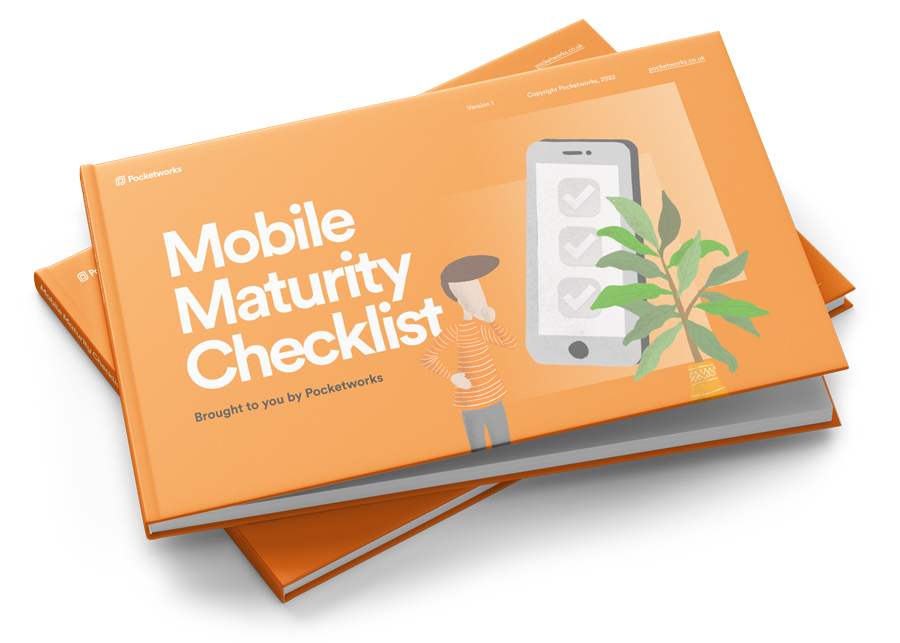This article is a high-level template for business leaders wanting to benefit from mobile apps and technology to satisfy customers or transform how they work. In other words, people who are looking to implement some degree of digital transformation and you need a mobile strategy to support it.
How do I use this blueprint?
This blueprint will help you identify the beginnings of a mobile strategy. It’s going to be rough and ready, but if you don’t have one then it will be immediately valuable and help you ask the right questions.
To get cracking, simply work through the questions below within 20 minutes or so. Grab a group to do this with – your CEO, sales director, operational director, or other department heads. Anyone who might have ideas around where technology could support you in your mission.
If you get stuck, the important thing is to just keep going to the end, and then plan to come back to it a week later. As you go, set action points to resolve any unknowns or questions that come up during the session. You can do those and bring resolved questions and unknowns to the next session.
What is the process?
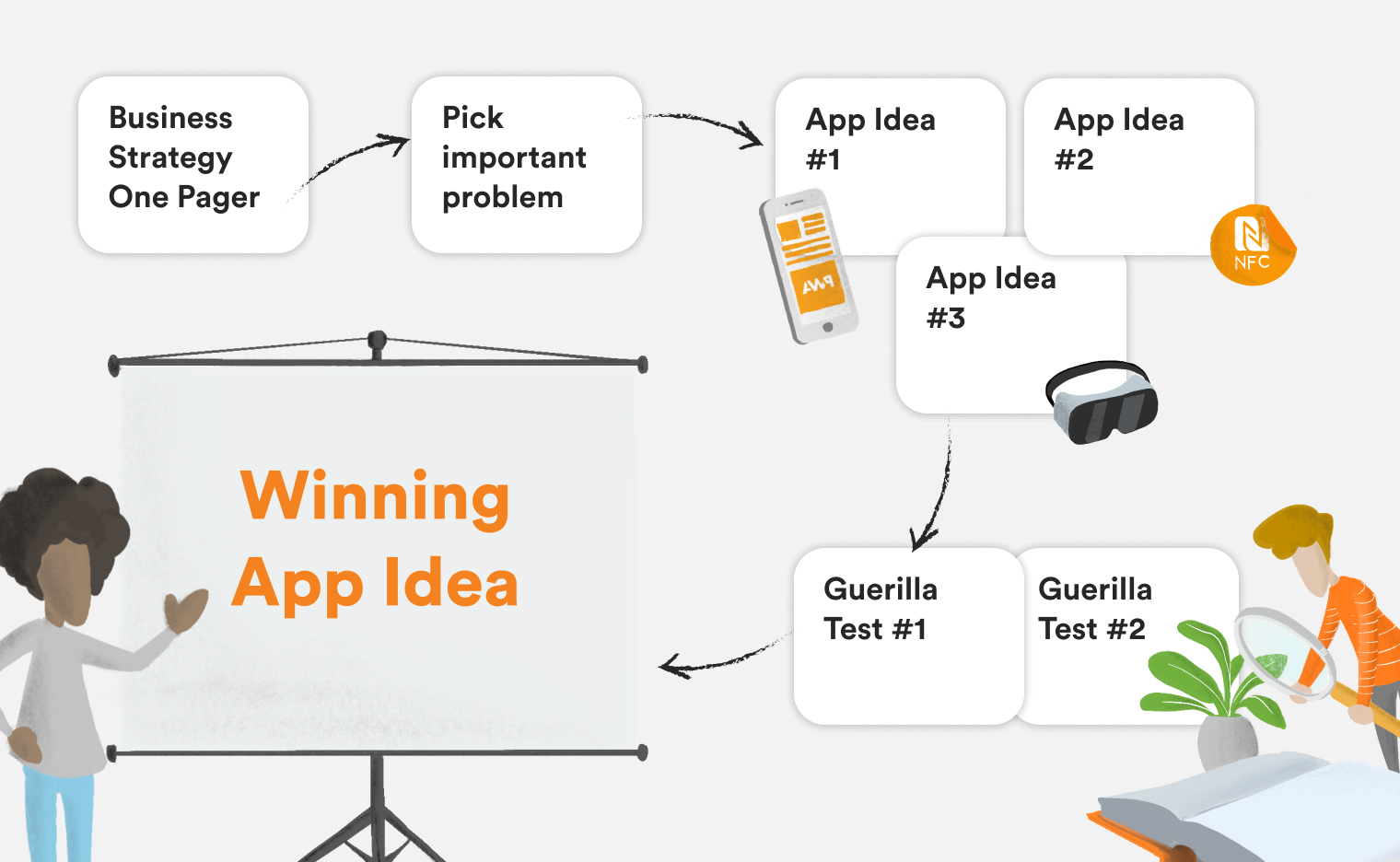
The diagram above shows the key things you need to do:
- Outline your current business strategy
You must know where the organisation is headed to ensure your mobile strategy pushes for that. At a high level, what does it mean for your organisation to be successful over the next 1-3 years?
- Identify the important problem or opportunity
Apps usually help you seize opportunities or solve customer problems. It's worth clarifying what problems or opportunities you believe mobile could help with. Be super clear about this**
- Generate ideas
The aim here is to generate 10–20 ideas and then narrow it down to 2–5. They might be fully fledged app ideas or mobile campaigns, whatever. Each idea has the potential to address the problem or opportunity you've outlined above. You should have safe ideas and also some bold, crazy ones.
- Test and validate ideas to remove potential risks
With some ideas on the table, you can now list what would have to be true for them to work. Is the app affordable? Will customers want it? Can it be done in a reasonable timeframe? Very few ideas are ready to go into production. There will be a risk that the ideas might not succeed. So, now is a good time to do identify barriers and run guerilla tests such as user research, paper prototypes, or even MVPs.
- Select the winning idea, then build a roadmap
Once you've tested the ideas and picked a winning one, it's time to work out the big pieces you could implement to achieve your strategy.
** Sometimes people want to learn how mobile apps can help their businesses. They are interested in exploring them but don't have an opportunity or problem to run at. So, they're really looking for inspiration. If this is the case, a good next step is to do some discovery and feed that into your strategy. For example, run a competitor analysis or survey customer attitudes and behaviours. A good mobile user-experience design agency should be able to help uncover some opportunities.
You can download a mobile strategy process diagram that gives you more details of this process
Mobile Strategy Process Overview
Perfect for CTOs starting a new roadmap. Get an overview of the strategic process that helps you develop your mobile strategy. This rigorous workflow helps you make better choices when developing your app.
Download the Process Overview
The key elements of a mobile strategy
The process outlined above can be shown in a slightly different way, which you may find helpful. The following diagram shows how it all ties together.
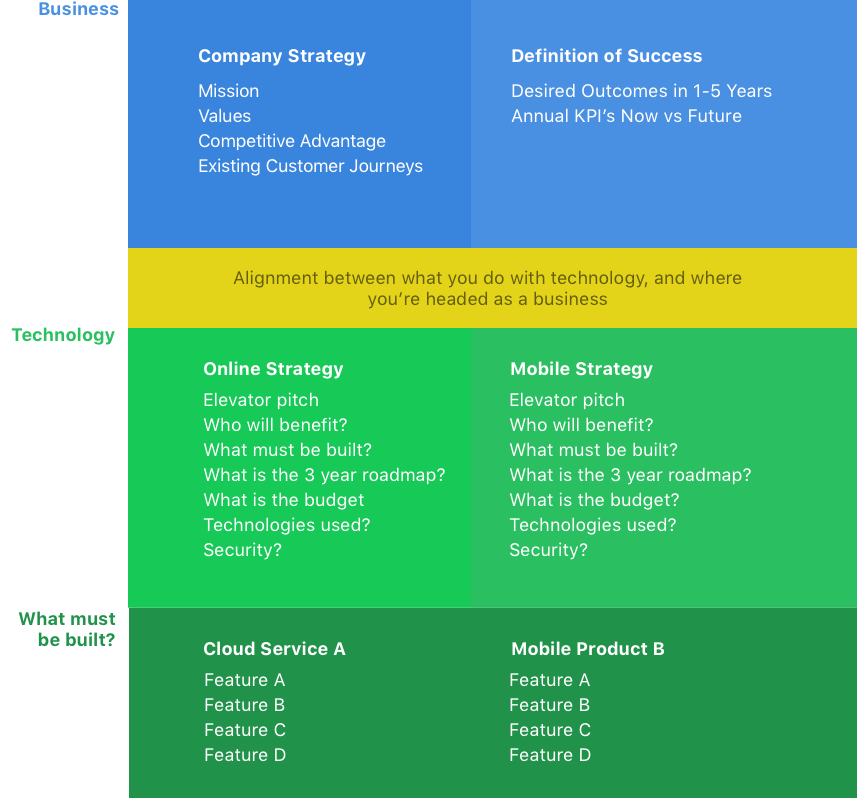
Here is an explanation of the diagram above.
- The Business: You have your business strategy at the top, along with the definition of success. This is sometimes called the Winning Aspiration.
- Alignment: When deciding what app to build, you need to check that it's aligned with your business strategy. Apps are usually expensive to build, so you must figure out how this pushes the most important goals forward in order to make an ROI case and get buy-in. If you're business is moving toward being Product Lead, this is even more important, as you'll need to justify an ongoing agile budget.
- Technology: Once you have generated ideas, evaluated them, and picked the winners, you'll have a good idea of the mobile apps and technologies that need to be put in place.
- What must be built: Knowing the strategic pieces you need won't guarantee success. You need to execute well. So you now move into the realms of UX and design to decide what must be bulit. Put another way, you've decided how to build the right thing; now you need to build the thing right. App designers will be asking themselves, "How do we build the thing in the best way to solve the problem or embrace the opportunity?". At Pocketworks, we're an agile mobile development agency, so we would advise not getting too hung up on detail during your strategic planning. Instead, form a cross-functional team to figure out what must be built in an incremental manner.
An example mobile strategy
We're building a set of examples you can refer to, along with materials to help you successfully build your own strategy. See the Fender example here.
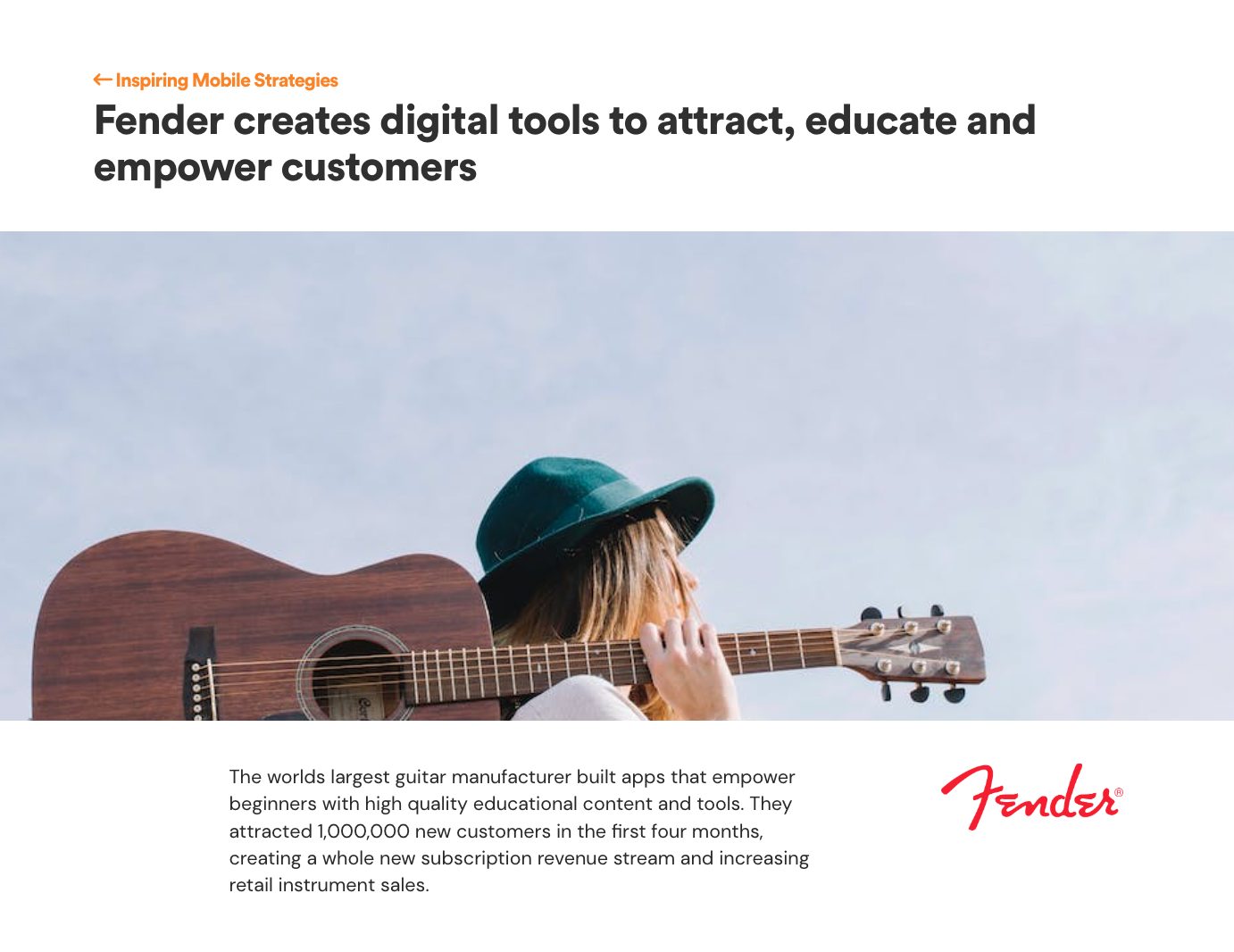
Oh, a quick interruption! If you like this article, you'll probably like our newsletter? It brings you loads of useful mobile insights and tips, helping you increase your mobile knowledge every two weeks 👇
Get inspiration from the world of apps.
Righty, now that you've signed up, let's get back to the article 😅
Download the template
The Strategy Choice Cascade is a great tool for capturing all the information outlined in this article.
You can download it here.
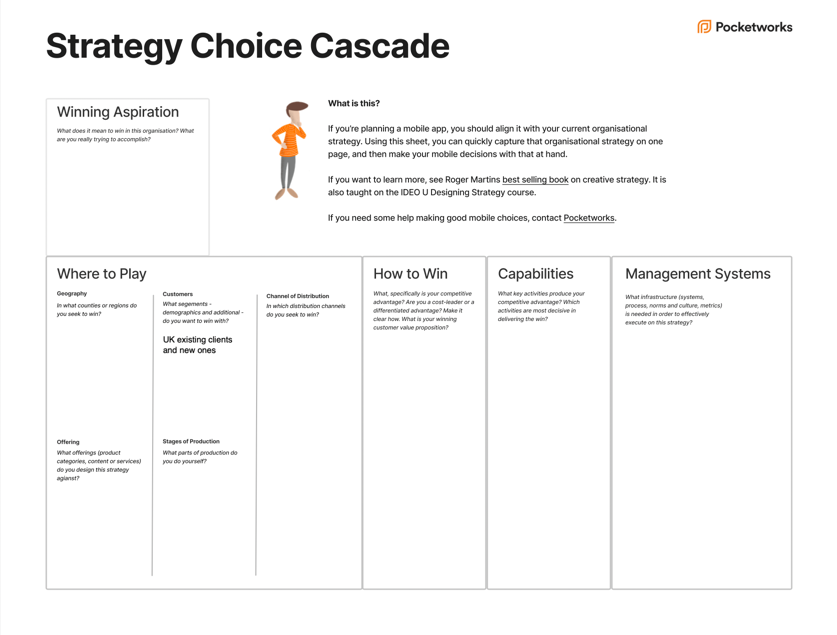
The process in depth
1. Restate your business aspiration
Apps and digital initiatives are simply tools to help you achieve your aspirations.
As you work on your mobile strategy, you'll need to ensure it pushes toward your business objectives. I'd suggest focusing on your 1-3 year goals for now.
Here are some examples of business or divisional aspirations:
- We want to expand our delivery services to cover the UK whilst becoming the most convenient option for our customers and raising our EBITDA to £80m.
- Offer the best employee experience in order to build the strongest talent pool to satisfy growing customer demand over the next 24 months.
- Scale up our sales and operations to bring value to 300 new corporate customers over the next 12 months.
- Help educate the market to enable smaller businesses to identify the need for our services, becoming the go-to educational resource in our sector over the next three years.
Can you identify the main aspiration of your department or company?
2. Decide what problem(s) you're solving
You understand what your organisation wants to achieve, but can you state the problem or opportunity you want to focus on?
Explore different ways to frame the problem:
- How might we grow our workforce to meet growing customer demands?
- How might we reduce workforce churn to meet growing customer demands?
- How might we generate more revenue from customers without increasing our workforce?
3. Generate ideas
Once framed, come up with ideas to tackle the problem you're trying to solve
- Offer more flexible working and better overtime pay to attract more candidates
- Double the size of our recruitment team to accelerate hiring
- Increase pay by 20%
This is a great starting point for a mobile strategy or digital strategy because you have ideas that can be supported by technology.
4. Tighten up your ideas into strategy headlines
Now that you have some rough-cut ideas, let’s tighten them up a bit by creating some strategy headlines. This just means fleshing them out a touch and thinking more about the benefits. Again, you need to be disciplined to avoid trying to solve everything (there are always dozens of ways to use tech to solve a problem). Focus on the problems you want to solve.
For example:
- Digitise the employee experience: We’ll give employees digital tools to answer their questions, understand policies, receive payslips, and book holidays. This will lead to reduced administration costs and increased employee education and happiness. See Digitising the employee experience for inspiration.
- Streamline ordering for mobile customers: We’ll make it much easier for our younger, more mobile customers to order from us on the move, leading to more orders and increased order sizes. See Streamlining B2b buying for inspiration.
- Digitise our paper catalogues: We’ll digitise our printed catalogues so our customers can find the product information they need more easily and benefit from more engaging and rich content such as videos and animations. This will lead to higher engagement, increased stickiness, and more sales.
- Etc..
So, if you make a list, these are pretty good strategy headlines to prioritise.
5. Evaluate each idea
With some good ideas on the table, it's useful to list out the things that would have to be true if that idea was implemented. For example, if you are a restaurant with the idea of developing a mobile app to enable customers to order home deliveries, some conditions might be:
- We can convince 5,000 customers to install our app, bringing £5K a week in mobile app transactions
- We can ROI within 12 months, meaning 2-year investment should be under £200,000
- Customers see value in a dedicated app for our restaurant
- There are no white-label products that do what we need for a fraction of the cost
Some of those conditions might concern you, some might not. The trick is to identity the ones that do concern you and flag them up as barriers to test.
6. Test barriers
Finding the best idea may require some testing. Testing can take many forms, from back-of-the-napkin financial forecasts and paper prototypes to fully fledged MVP products.
Taking the restaurant example above, which of those conditions worries you? Let's say you pick this one:
- Customers see value in a dedicated app for our restaurant
How might you test this? Here are some ideas. A single £ means inexpensive, and more ££ means more expensive to test.
- £ A competitor analysis of other dedicated restaurant apps
- ££ A customer survey
- £££ A coaster or flyer promoting the app with an email capture link
- ££££ Showing customers a prototype of the app idea
- £££££ Building a small version of the app and launching it, then measuring uptake
7. Pick and idea and set out your development roadmap
If you're tests went well and the strategic opportunity is viable, you can commit to this opportunity and set out a roadmap to implementation. There may be many parts to your app, and some will have a bigger impact than others. We're big fans of the Now, Next and Future format for roadmaps to avoid trying to get to hung up on delivery dates. If it's important it's worth getting right.
Now
- Baseline app enabling customers to arrange parcel pickup and dropoff
- Smarter driver route calculation to speed up delivery times
Next
- Same day collection
- Repeat pickups
Future
- Integrate with aggregators
- Delivery ratings
- Customer ratings
8. Repeat for more problems in the business
You are likely to have more than one app idea that will progress your business toward it's goal. An obvious way of prioritising what you do is to simply look at the ROI case. Then list them out in order with a rough timeline. You can normally make good progress on any strategic initiative in 3-6 months, so chop your initiatives up into 3-6 month blocks.
For example:
- 2023 Q1 – Q2
Offer dynamic pricing informed by AI
- 2023 Q3 – Q4
Self-service customer support to reduce call centre burdon
- 2023 Q1 – Q2
Digitise the employee experience (phase 1)
- 2024 Q1 – Q3
Streamline ordering for mobile customers (phase 2)
- 2024 Q1 – Q2
Organic growth loop
Sometimes you lean on your gut rather than hard data for ROI. This is fine, and don’t worry if you don’t have all the details. This is about setting your best guess in a strong direction. Your shining star for the future.
If this strategy is aligned with your goals, and you have some confidence in the direction you’re heading, you won’t have to change it much. Instead, you’ll later focus your energies on how to do each phase right.
Great, what’s next?
You have your goals, and strategy headlines of how you might use technology to support those goals, and you’ve turned it into some kind of prioritised roadmap.
Next, you’ll need to define the strategies and products that will realise this strategy. We’ll cover that in a future article. If you want a more detailed version, here’s the process we go through with clients that you can use for free.
Should you worry about costs at this point?
You won’t need budgets to set your strategy. Once you’ve set your digital direction and prioritise, you then can think about what you can invest in each of those, perhaps using the ROI case to guide the investment.
There are many ways to crack a nut, so it’s very likely you can find a way to progress your strategy with small or huge budgets. For example, you might be able to increase mobile sales without building an app. Your mileage will vary depending on your budget, but any good advisor should help you find quick wins at the start of your project.
A UK app developer such as Pocketworks could help you figure out the rough costs.
Wrapping up
If you do this, it will start getting you asking the right questions and thinking about technology as something that supports your mission and goals. It might surprise you, but many companies don’t do this. So if you’ve got through it you’ve already given more consideration to your strategic adoption of technology than most.
Note: You can call on outside experts to help with this. If you don’t have an app strategy partner, we’d be happy to help. We run workshops and advisory sessions to help businesses create a strategy for their business. Feel free to get in touch if you want some help. Good luck!






